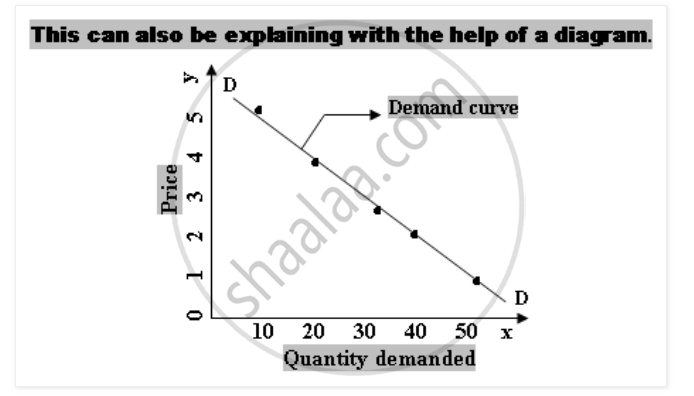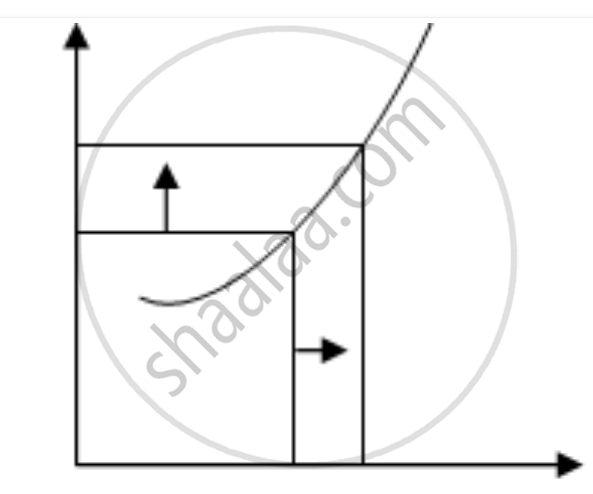Advertisements
Advertisements
प्रश्न
Write Explanatory answer.
State and explain the law of demand with its exception.
उत्तर
Meaning: -The Law of demand establishes the functional relationship between the Price of a commodity and the quantity of that commodity demanded at different prices, assuming other factors remaining constant.
When the price of a commodity rises, demand for it falls and when the price of the commodity falls, demand rises. So less quantity is demanded at higher prices and more quantity is demanded at lower prices. There exist inverse relationship between price and quantity demanded of a commodity.
Definition: -According to Marshall the law of demand, is defined as “Other things being equal, the quantity of a commodity demanded varies inversely with its price.”
Symbolically, the Law of demand can be expressed as follows:
Dx = f (Px)
Where, D = stands for the demand for commodity X
X stands for the commodity demanded
F stands for function of
Px stands for the price of the commodity X
We can explain this law with the help of a schedule and a diagram.
| Price (Rs.) | Quantity Demanded |
| 1 | 50 |
| 2 | 40 |
| 3 | 30 |
| 4 | 20 |
| 5 | 10 |
The Schedule shows that with an increase in Price the quantity demanded is decreasing. It indicates inverse relationship between the two variables price and quantity demanded. When the price is Re. 1 the consumer demand 50 units and when the price rises to Rs. 5 he demands the least that is 10 units.

In the above diagram X-axis represents quantity demanded and Y-axis represents price. Various points from the schedule are plotted on the graph, joint those points we will be getting demand curve. DD is the demand curve which slopes downward from left to right indicating inverse relationship between price and Quantity demanded. This happens when the price is more, demand is less and when price is less, and demand is more.
- Giffen goods or inferior goods-Giffen Paradox: -Inferior goods are those goods whose demand does not rise even if their price falls. At times, the demand decrease, when the price of such gods falls. Sir Robert Giffen discovered this behaviour in England in relation to inferior goods such as bread. Therefore inferior goods are named after Giffen and they called ‘Giffen Goods’.
- Prestige Goods: There are certain goods and services, which represent ‘Status’ of ‘Prestige’for the people. Demand for these commodities is more when the price is more.
- Anticipation of changes in price: -If people anticipate a further rise in price, they may buy more at the existing higher price. Likewise, if people anticipating a further fall in price, they will not buy more even at the existing lower prices. They will wait for the price to fall further.
4. Price Illusion: -There is a belief among the people that the higher is the price, the better is the product and accordingly the greater is the demand for such goods.

- Changes in fashion: The law of demand may not work, if there is change in fashion. For example, if a product goes out of fashion and its price falls down, people will not buy more of it even at very low prices.
- Promotional activates: - Promotional activities such as advertising and salesmanship undertaken by seller can make the people buy more even at high prices.
- Changes in quality: if there is a change in the quality of the product, the law of demand may not apply. For instance, if there is improvement in quality of the product, some people my demand more even at higher price.
संबंधित प्रश्न
| Group 'A' | Group 'B' | ||
| a. | Pen and ink | 1 | Quantity-price |
| b. | Revenue | 2 | Accident |
| c. | Insurable risk | 3 | Transfer income |
| d. | Unemployment allowance | 4 | Short period |
| e. | Reverse repo rate | 5 | Long period |
| 6 | Change in demand | ||
| 7 | Joint demand | ||
| 8 | Quantity * price |
Compare inelastic demand with perfectly inelastic demand.
Explain the problem of what to produce.
Any statement above demand for a good is considered complete only when the following is/are mentioned in it. ( choose the correct alternative)
a) Price of the good
b) Quantity of good
c) Period of time
d) All of the above
Distinguish between ‘increase in demand’ and increase in quantity demanded of a good.
When is demand called perfectly inelastic?
State the factors leading to fall in demand by an individual consumer
State with reason. Whether you ‘agree’ or ‘disagree’ with the following statement:
There are no exceptions to the law of Demand.
Fill in the blank with proper alternatives given in the bracket:
Indirect demand is also known as _______ demand.
State whether the following statement is true or false.
Perfectly inelastic demand curve is parallel to ‘X’ axis.
Fill in the blank using proper alternatives given in the bracket:
Demand for salt is ...............
Answer the following question.
State and explain the law of demand.
Fill in the blanks using proper alternatives given in the brackets.
Demand for car and petrol is ____________ de
Write whether the following statement is True or False:
Demand for commodities depends upon various factors.
Fill in the blank with appropriate alternatives given in the bracket:
The law of demand states ________ relation between demand and price.
Write answers in ‘one’ or ‘two’ paras each.
What are the main determinants of aggregate demand?
Explain the following concepts or give definitions.
Demand
State whether the following statement is TRUE and FALSE
Demand curve slopes upward from left to right.
State whether the following statement is TRUE and FALSE
Quantity demanded varies directly with price.
Give reason or explain the following statement.
Demand curve slopes downward from left to right.
Answer the following question
What do you mean by demand?
Fill in the blank using appropriate alternatives given below
The demand for perishable goods is _______
Distinguish between normal goods and inferior goods, with examples
If the income of a consumer increases, discuss briefly its likely impact on the demand for a inferior good, Good X.
Answer the following question:
Elaborate the law of demand, with the help of a hypothetical schedule.
Which of the following points are related to the 'Paradox of Thrift'?
Increase in price of substitute goods leads to ______
What will be the effect on equilibrium price and equilibrium quantity when income increases in case of normal goods?
Area under MC curve is equal to:
Which of the following can cause an increase in demand:
Which of the following statements is correct with respect to the correction of Excess Demand?
Which of the following is correct?
Which of the following statements is true?
Which of the following statements is false?
Identify the market form which has indeterminate demand curve:
Read the following news report and answer the Q.97-Q.100 on the basis of the same:
The quantity of a commodity that a consumer is willing to buy and is able to afford, given the prices of goods and the consumer's tastes and preferences is called demand for the commodity. Whenever one or more of these variables change, the quantity of the good Chosen by the consumer is likely to change as well. The relation between the consumer's optimal choice of the quantity of a good and its price is very important and this relation is called the demand function. Thus, the consumer's demand function for a good gives the amount of the good that the consumer chooses at different levels of its price when the other things remain unchanged.
Assertion: The income of the consumers remains unchanged
Reason: Commodity should be a normal good.
Select the correct alternative from the following.
Read the following news report and answer the Q.97-Q.100 on the basis of the same:
The quantity of a commodity that a consumer is willing to buy and is able to afford, given the prices of goods and the consumer's tastes and preferences is called demand for the commodity. Whenever one or more of these variables change, the quantity of the good Chosen by the consumer is likely to change as well. The relation between the consumer's optimal choice of the quantity of a good and its price is very important and this relation is called the demand function. Thus, the consumer's demand function for a good gives the amount of the good that the consumer chooses at different levels of its price when the other things remain.
In which of the following cases there will be leftward shift in demand?
Which of the following statement is true?
When the price of the commodity has changed the demand for the commodity changes in ______
In an open economy, Aggregate Demand is estimated as:
Which of the following statements is true?
Milk is used for making curd, sweets and chocolates.
What type of demand does milk have? Give a reason.
Read the passage given below and answer the questions that follow.
|
In India, Fixed deposits have long been a favourite investment choice of people, especially senior citizens, as it promise steady returns. It attracts those who are seeking a stable income. But it’s an illusion in the period of inflation. Inflation is the rate at which the general level of prices for goods and services rises, subsequently eroding the purchasing power of money. In simple terms, what money could buy today might not a few years down the line. Fixed deposits are financial instruments offered by banks where you deposit a lump sum amount for a fixed period at a predetermined rate of interest. Consider an investment of Rs 1 crore in a fixed deposit at a 6% annual interest rate and the annual rate of inflation is 5%. By the 10th year your pre inflation return is 1.79 crore, but post inflation it’s just 1.10 crore. The nominal value of investment in fixed deposits may appear to grow, inflation significantly diminishes their real value and purchasing power over time.
|
- What is the theme of the extract? (2)
- Differentiate between Demand pull and Cost push inflation. (2)
- What are the demand deposits and time deposits? (2)
- Since 1998 RBI has been using new measures of money supply, M0, M1, M2 and M3. Which one of these measures incorporates fixed deposit as one of its components? Mention the other components of that measure. (2)

